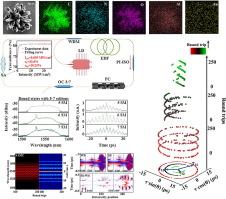Generation and π-phase-induced oscillations of multi-soliton molecular complexes in ultrafast fiber lasers based on MOF-253@Au
IF 13.2
1区 工程技术
Q1 ENGINEERING, CHEMICAL
引用次数: 0
Abstract
Multi-soliton molecular complexes (multi-SMCs) have been extensively studied in the fields of nonlinear science and information coding due to their remarkable and rich molecular-like interactions. To efficiently harness the output of multi-SMCs and thus explore the intricate interactions among tightly bound multiple solitons for intelligent control, we apply the unique metal organic framework (MOF)-253@Au to the field of ultrafast photonics. The material has the characteristics of large surface area, modulation depth of 33.6 %, narrow band gap of 2.3 eV, and saturation absorption intensity of 0.039 MW/cm2. Using MOF-253@Au as the saturable absorber in the ring cavity, a bound state comprising up to 7 solitons is generated. Both theoretical analyses and experimental results elucidate the dynamics of diverse soliton oscillation (periodic and bi-periodic behaviors) and soliton competition in multi-SMCs with both symmetric and asymmetric intensity. Most of the oscillations are induced by the near-π phase difference in the sliding phase between main soliton and others. The discovery of these dynamics expands the application of MOF in ultrafast optics and is poised to advance the development of multi-SMCs in intelligent light regulation.

基于MOF-253@Au的超快光纤激光器中多孤子分子复合物的产生及π相激振荡
多孤子分子配合物(多孤子分子配合物)具有丰富的类分子相互作用,在非线性科学和信息编码领域得到了广泛的研究。为了有效地利用多smcs的输出,从而探索紧密结合的多孤子之间复杂的相互作用以进行智能控制,我们将独特的金属有机框架(MOF)-253@Au应用于超快光子学领域。该材料具有比表面积大,调制深度为33.6% %,窄带隙为2.3 eV,饱和吸收强度为0.039 MW/cm2的特点。利用MOF-253@Au作为环腔中的可饱和吸收剂,产生了包含多达7个孤子的束缚态。理论分析和实验结果都阐明了对称和非对称强度的多smcs中各种孤子振荡(周期和双周期行为)和孤子竞争的动力学。大部分的振荡是由主孤子与其他孤子滑动相位的近π相位差引起的。这些动态的发现扩展了MOF在超快光学中的应用,并有望推动智能光调节中多smcs的发展。
本文章由计算机程序翻译,如有差异,请以英文原文为准。
求助全文
约1分钟内获得全文
求助全文
来源期刊

Chemical Engineering Journal
工程技术-工程:化工
CiteScore
21.70
自引率
9.30%
发文量
6781
审稿时长
2.4 months
期刊介绍:
The Chemical Engineering Journal is an international research journal that invites contributions of original and novel fundamental research. It aims to provide an international platform for presenting original fundamental research, interpretative reviews, and discussions on new developments in chemical engineering. The journal welcomes papers that describe novel theory and its practical application, as well as those that demonstrate the transfer of techniques from other disciplines. It also welcomes reports on carefully conducted experimental work that is soundly interpreted. The main focus of the journal is on original and rigorous research results that have broad significance. The Catalysis section within the Chemical Engineering Journal focuses specifically on Experimental and Theoretical studies in the fields of heterogeneous catalysis, molecular catalysis, and biocatalysis. These studies have industrial impact on various sectors such as chemicals, energy, materials, foods, healthcare, and environmental protection.
 求助内容:
求助内容: 应助结果提醒方式:
应助结果提醒方式:


